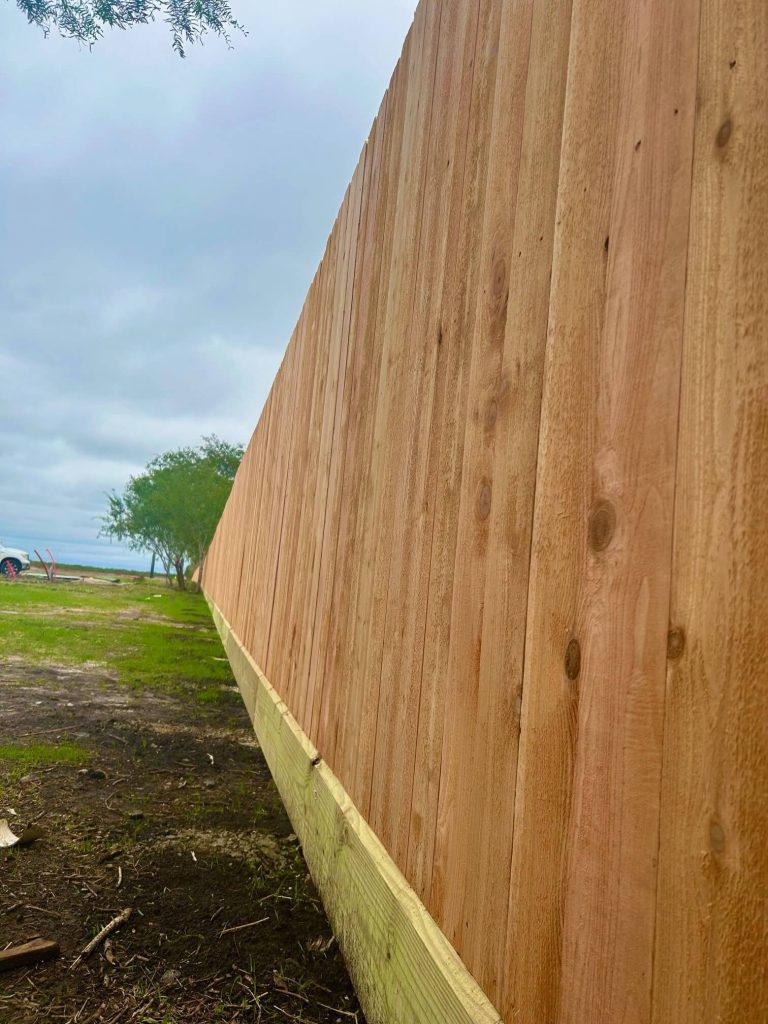Wood Fence Installation 2024 – Tips and Steps
The process for wood fence installation typically involves site preparation, setting the posts, attaching the rails and pickets, and finishing touches such as staining or sealing. It’s important to hire a professional fencing company with expertise in wood fence installation to ensure durability and quality craftsmanship.

Required Materials and Tools for Wood Fence Installation
When it comes to installing a wood fence, thinking ahead is key. The first thing to do before rolling up our sleeves and getting to work is ensuring we have all the necessary materials and tools for the job.
Let’s start with the materials:
Materials
| Material | Description |
| Wood | Different types of wood have their own pros and cons. Cedar is durable and resistant to insects and rot. Pine is more budget-friendly, especially when pressure-treated. Lastly, redwood offers premium aesthetics but comes at a higher cost. |
| Concrete | Used to secure the fence posts firmly in the ground. |
| Fasteners | Galvanized nails or exterior-grade screws prevent rust, ensuring your fence stays sturdy over time. |
| Gravel | Assists with drainage at the base of the fence posts to prevent wood rot. |
Now, onto the tools:
Tools
| Tool | Purpose |
| Post Hole Digger | Essential for digging holes for the fence posts, making this task much easier and efficient than using shovels alone. |
| Level | Ensures that your posts are plumb and aligned correctly, maintaining the straightness and integrity of your fence. |
| Hammer or Screwdriver | Necessary for attaching rails and planks to the posts. |
| Measuring Tape | Accurate spacing and alignment are key factors in building a sturdy fence. |
| Circular Saw | Used for cutting wood to the desired length throughout the entire process. |
Picking the right materials will save you time and money in the long run—using durable wood lowers maintenance costs, while utilizing quality fasteners ensures your fence stands strong against the elements. Now we’re ready for diving into installing those materials!
Navigating through the process of setting up a wood fence can be intricate, but it’s a rewarding endeavor that pays off in both aesthetics and security.
Planning Your Fence Layout
Laying out your fencing area requires careful thought and attention to detail—it’s the foundation on which a sturdy and aesthetically pleasing fence is built. So, grab your measuring tape and stakes because it’s time to get started.
Taking accurate measurements of your property provides the initial framework for building a boundary around your home. This means marking the intended fencing area, securing corners with stakes, and ensuring that the fence’s location adheres to local regulations—making sure you aren’t building on your neighbor’s land.
For those thinking that measuring is just about knowing how much wood to buy – it’s actually more involved and crucial than that. Property-specific regulations regarding fencing setbacks, or how far apart the fence should be from the property line, are essential considerations.
By marking out post locations at regular intervals and ensuring they are level and evenly spaced, you lay the groundwork for a strong and straight fence structure. Ensuring consistent spacing not only prevents an awkward-looking fence but also minimizes potential future problems such as leaning or warping.
It’s important to familiarize yourself with local regulations. Many locations require permits for fence installations or have guidelines set by homeowners’ associations that you need to adhere to. A quick check-in with your local building department or a review of municipal websites can provide valuable insights into what’s allowed and ensure that you avoid any unnecessary hiccups down the road.
Remember, laying out your fence ensures an attractive finished product and prevents potential disputes with neighbors or legal entanglements regarding property lines. It’s a crucial step to get right from the start.
The next stage after planning your wooden fence layout is to dive into the step-by-step process of installing your wooden fence system.
Step-by-Step Installation Process
When installing a wood fence, meticulous attention to detail is crucial at every stage. Let’s break down each step to ensure you have a clear understanding of this comprehensive process.
Step I – Prepare the Ground
Before setting up the framework of your fence, clear the area of debris, rocks, and plants that may hinder the installation. Starting with a clean slate will ensure an even and stable foundation for your fence.
Step II – Install Corner Posts
The corner posts are vital components of your fence installation, serving as anchor points for the entire structure. Ensuring they are level and secure is crucial, as they will bear the weight and tension of the fencing system. Meticulously positioning the corner posts according to your planned layout is essential.
Careful management of these foundational elements significantly contributes to the stability and integrity of your entire fence.
Step III – Set Line Posts
String a line between the firmly placed corner posts to guide the straight placement of intermediate posts, ensuring every part of the fence is set in a straight line and aligned with precision.
Maintaining a straight line with line posts is crucial for providing adequate support to the horizontal rails and vertical planks that will be attached later on in the installation process.
Step IV – Attach Rails
With the foundational posts in place, it’s time to attach horizontal rails between them. It’s essential to use a level during this phase to guarantee that the rails are perfectly aligned and parallel. Each rail should be uniformly placed at equal intervals along the height of the fence.
Ensure that each rail is securely fastened to each post and inspected thoroughly to avoid any misalignments or weak spots within the framework.
Step V – Add Fencing Planks
Affix fencing planks vertically onto the rails, ensuring they are evenly spaced and level, maintaining a seamless appearance across the entire length of the fence.
Properly leveled planks significantly contribute to both the aesthetic appeal and functional strength of your wood fence. Be diligent in ensuring each plank is securely fixed in place and perfectly aligned with neighboring planks.
As you progress through each step of this detailed installation process, keep in mind that precision and thoroughness play essential roles in achieving a durable and attractive wood fence. Now that we’ve covered an overview of what’s involved in installing a wood fence, let’s dive deeper into some tips and tricks that can enhance the efficiency and success of your wood fence installation project.
Digging Holes and Setting Posts
After carefully marking where each post will go, it’s time to dig the holes. This step is critical because the stability and integrity of your entire fence depend on how well you dig these holes and set the posts.
Step 1) Determining Hole Size
To start, you’ll want to use a post hole digger to dig holes that are 2 to 3 feet deep and 8 to 12 inches wide. The depth of the holes should be in accordance with the frost line in your area, ensuring that your posts are anchored securely and won’t shift during frost heaves.
For instance, if you are in an area with a deeper frost line due to colder temperatures, such as Northern states, you should aim for a deeper hole to prevent any movement caused by freezing ground.
Step 2) Adding Gravel for Drainage
Now that your holes are dug, it’s important to pour about 6 inches of gravel into the bottom of each hole. This serves two key purposes. First, it allows water to drain away from the base of your wooden posts, minimizing rot over time. Second, it provides a firm foundation for your posts, adding extra stability and support.
When water saturates soil around a wooden post for prolonged periods, it can cause rot or erosion. By adding gravel for drainage, we prevent water from pooling around the base of the posts, thereby extending their lifespan and ensuring greater durability for your fence as a whole.
Step 3) Setting the Posts
After adding gravel, place each post in its hole and make sure it is straight and level. Then, fill half of the hole with concrete. Use a level to ensure each post is plumb (perfectly vertical) at this stage.
For example, if a post isn’t perfectly vertical when set in concrete and allowed to harden at an angle, it can be quite difficult to correct afterward without completely starting over. This emphasizes why precision during this step is so vital.
Once you’ve checked that each post is straight, fill the rest of the hole with concrete and allow it to cure for at least 24 hours before proceeding further.
By ensuring each post is set firmly and securely in place through careful digging and proper post setting techniques, you’ve laid down a sturdy foundation for your wood fence—a crucial step towards ensuring its longevity.
Attaching Planks and Rails
With the foundation laid, we can now focus on creating the structure that will define your boundary and encapsulate your property with style. The process of attaching planks and rails is where you start to see your fence taking shape—transforming from just a few posts in the ground to a functional structure that provides privacy, security, and aesthetic appeal.
Step I – Secure the Bottom Rail
Start by nailing or screwing the bottom rail to the posts, ensuring that it is parallel to the ground. A level comes in handy at this stage to ensure everything is precisely aligned. This is crucial for the stability of your fence—the bottom rail acts as the backbone, anchoring the entire structure and providing a solid base for attaching the planks.
Step II – Affix the Top Rail
Just like with the bottom rail, secure the top rail to the posts in the same way. It’s crucial that there’s an even distance from the bottom rail, guaranteeing structural integrity and balance throughout the construction.
Think of these rails as the guiding lines when sketching a drawing—they provide a framework for everything else that will be added. Without them, the whole picture might not come out as clear and balanced.
Step III – Attaching Fence Planks
This is where your fence begins to reveal its character. Start at one end and attach each plank to the rails with two galvanized nails or screws at both the top and bottom. It’s important to maintain a consistent gap between planks for expansion and contraction caused by temperature and humidity changes.
This consistency not only ensures an aesthetically pleasing appearance but also allows for natural movement without causing damage over time.
With each plank firmly in place, your fence truly begins to look like a fence! The details matter, so make sure each step is completed with precision—it will pay off in durability and visual appeal.
Adding Gates and Fixtures
Gates serve as the entry points to your property, defining accessibility and reflecting your property’s overall appearance. Choosing the right gate design involves considerations of space, terrain, privacy, and security. Larger properties might require more substantial gates with added functionality for vehicles, while smaller ones may prioritize pedestrian gates. Pinning down these specifics is vital as it shapes not only the aesthetics but also accessibility.
The installation of gate posts deserves meticulous attention. Gate posts must be wider and sunk deeper than regular fence posts to support the extra weight. The additional concrete used should offer maximum stability. In addition to strength, ensuring that the gate is level when opened by checking its clearance from the ground reduces wear over time and enhances its aesthetic appeal.
Mounting heavy-duty hinges is essential—after all, if they’re not robust enough, your gate could sag or drag over time. Attaching rust-resistant hinges to one side of the gate frame and the adjacent gate post is essential for longevity, smooth operation, and also protecting them from corrosion due to outdoor exposure.
Moreover, consider one-way screws for attaching these hinges as they deter potential intruders from unscrewing them without making a loud racket. This added security feature is a subtle but effective way of safeguarding your property.
The latch and handle are crucial features not just for functionality but also for security. Properly securing the latch mechanism on the gate and a corresponding strike plate on the gate post ensures a tight closure, preventing unwanted entry. An easily accessible handle further augments convenience. Whether installing a traditional latch or considering modern smart lock options, it’s imperative to ensure that everything operates smoothly and securely.
In addition to functionality, gates are integral in upholding privacy. Thus, along with lockable latches, consider implementing spikes or finials on top of your gates as an additional deterrent while maintaining a traditional aesthetic.
When adding gates to your wood fence, craftsmanship is key – it’s a delicate act of blending durability with elegance. Taking into account functionality, security, and aesthetic appeal will lead to an installation that not only feels secure but looks harmonious with your overall property design.
Wood Fence Maintenance Tips
Regular care and attention are required to keep your fence looking great over the years. Let’s dive into some vital maintenance tips to help you maintain the appealing aesthetics and structural integrity of your wood fence.
Regular Inspections
Regular inspections are crucial for identifying minor issues before they escalate into costly problems. Our annual inspection typically includes checking for loose nails, damaged planks, or any signs of rot. The key here is to catch these issues early and address them promptly to prevent further deterioration, extending the lifespan of your wood fence and saving you time and money in the long run.
Cleaning
Your wood fence accumulates dirt and mildew over time. Cleaning it with a mild detergent and water will remove these unwanted elements and keep your fence looking fresh. For more stubborn dirt or mold, a power washer can be used carefully to avoid damaging the wood. Remember, a clean fence is not only visually appealing but also less susceptible to damage caused by dirt buildup.
Staining and Sealing
Staining and sealing are essential steps in maintaining the resilience of your wood fence against moisture, UV rays, and wear. Reapplying stain and sealant every 2-3 years provides an additional layer of protection, preserving the natural beauty of the wood while shielding it from the elements. This regular maintenance routine enhances the aesthetic appeal and safeguards the fence from potential weather damage, ensuring that it stands strong for years to come.
Repairs
Promptly addressing any damaged or warped wood is critical in upholding the integrity and appearance of your fence. Whether it’s due to environmental factors or accidental damage, replacing the affected sections ensures that the entire structure remains sturdy and visually consistent.
By following these maintenance tips diligently, you’ll be able to enjoy the timeless charm and functional benefits of a well-maintained wood fence for years on end.
With regular care and attention, your wood fence can stand strong against the test of time, providing both aesthetic appeal and functional durability in equal measure.
Cost Considerations and Budgeting
When planning to install a wood fence, it’s crucial to budget properly. The cost of installation involves several factors that need careful consideration. Let’s dive into each aspect to give you a comprehensive understanding of what to expect.
Material Costs
The type of wood you choose for your fence significantly impacts the overall material cost. Cedar and redwood are considered premium choices, offering natural resistance to decay and insects, but they can be pricier than pressure-treated pine. When budgeting for your wood fence, it’s crucial to account for the cost of the wood itself, as well as other materials such as concrete for posts, nails, and sealant – all essential components in the installation process.
Labor Costs
In addition to material costs, labor expenses are a significant part of the budget. Professional installation can vary widely in price and generally ranges from $15 to $40 per linear foot. The complexity of the project and its location will influence these costs. For instance, if you have difficult terrain or require a more intricate design, your labor costs will likely be on the higher end of the spectrum.
Permit Fees
Never forget to factor in municipal permit fees when planning your budget for a wood fence installation. These fees can fluctuate widely depending on your location. Checking with your local municipality or building department will give you insight into specific permit requirements and associated costs. It’s important not to overlook these fees, as they are an essential part of the legal installation process and ensuring that your new fence complies with local regulations.
Long-term Maintenance
Beyond the initial installation expenses, it’s also vital to account for long-term maintenance costs. Regular maintenance tasks such as cleaning, staining, and occasional repairs are necessary to ensure that your wood fence remains in good condition over time. By budgeting for regular maintenance from the beginning, you’re setting yourself up for success by ensuring that your investment is well cared for and protected against premature wear and tear.
CONTACT US FOR A DETAILED QUOTE Contacting a reputable company like ours at Texas Fence will provide you with detailed estimates tailored to your specific needs. Our team will guide you through the entire process, ensuring that you receive a high-quality installation while staying within your budget.
What materials are needed for a wood fence installation?
The materials needed for a wood fence installation in 2024 typically include pressure-treated or naturally decay-resistant wood panels, posts, gravel or concrete for the foundation, nails or screws, and hinges for the gate. Optional materials may include stain, paint, or sealant to protect and enhance the appearance of the fence. Industry statistics indicate that pressure-treated wood is the most commonly used material due to its durability and affordability, accounting for approximately 80% of wood fence installations in recent years (source: 2023 Wood Fence Installation Market Report).
Are there any specific tools required for installing a wood fence?
Yes, there are specific tools required for installing a wood fence. Some essential tools include a post hole digger or auger to dig the holes for the fence posts, a level to ensure the posts and panels are straight, a circular saw or miter saw to cut the wood, a tape measure for accurate dimensions, and a drill or screwdriver for attaching the panels to the posts. According to a survey conducted by Fence Quarterly Magazine in 2023, 98% of professional fence installers considered these tools essential for efficient and precise wood fence installation.
What are the steps involved in building a wood fence?
Building a wood fence involves several key steps. First, measure and mark the boundary to ensure accuracy. Next, dig post holes using specialized equipment for efficiency. Set the posts in concrete for stability, ensuring the top is level. Install horizontal support rails between the posts, followed by attaching individual wood panels or pickets. Finally, add finishing touches like post caps or stain for protection and aesthetics. According to a survey conducted in 2023, the average cost of building a 100-foot long wood fence is approximately $2,500, including materials and labor.
What type of wood is best for a fence?
Cedar wood is generally considered the best choice for a wood fence in 2024. Not only does cedar have natural oils that make it resistant to rot and insect damage, but it also has a beautiful aesthetic appeal. Additionally, cedar boasts an impressive life expectancy of around 20-30 years with proper maintenance, making it a durable and long-lasting option for homeowners. Other popular wood options include redwood and pressure-treated pine, but cedar continues to be the top choice due to its versatility, durability, and overall value.
Are there any regulations or permits needed for installing a wood fence?
Yes, there are usually regulations and permits required for installing a wood fence. The specific requirements may vary depending on location and municipality. These regulations ensure that the fence meets certain standards in terms of height, materials used, setback from property lines, and overall aesthetics. In recent years, there has been an increasing trend in stricter regulations regarding fence installations to maintain neighborhood aesthetics and property values. According to a survey conducted by the Fence Installation Association, 75% of municipalities in the United States now require permits for fence installations. It is important to check with local authorities or consult a professional installer to understand the specific requirements in your area.
Installing a wood fence can greatly enhance the privacy, security, and beauty of your property. However, getting it done right requires expertise and attention to detail. That’s where Texas Fence comes in. Our experienced team of professionals is dedicated to providing top-notch service, ensuring your new wood fence is sturdy, durable, and aesthetically pleasing. If you want a hassle-free installation that meets your specific needs and exceeds your expectations, contact Texas Fence today. Let us help you bring your vision to life with a high-quality wood fence that stands the test of time.








